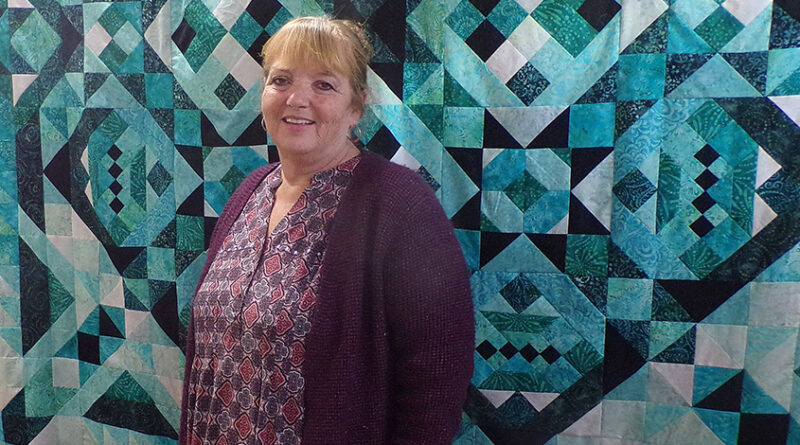The Robin’s Nest Hatches Quilts — and Memories
Robin Hall of Fulton worked with people with disabilities for 33 years. Then she started her own quilting shop. She is now celebrating 10 years in business
By Stefan Yablonski
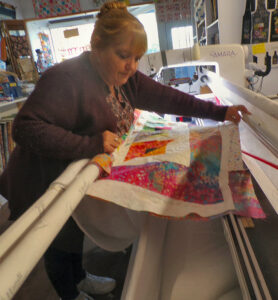
Robin Hall’s ‘nest’ is a cozy little shop tucked away along West Broadway in Fulton. The walls are adorned with swaths of fabric, quilts — large and small, and everything else a quilter might need.
Hall, 58, was born and raised in Sterling; one of five children. She went to school in Red Creek and attended college at Cayuga Community College. She married and raised two daughters and two step daughters.
“I worked at Oswego Industries as a supervisor with disabled adults for 33 years,” she said.
While attending high school, in her sophomore year, she took an art class where a semester was spent on a batiking class.
“This process is done using wax and dyes. Waxing all parts of the fabric except for which color you want to dye your fabric the first color; then removing wax from the next sections while covering the part you just dyed, this continues until you have all the colors and the design you’re looking to achieve,” she explained. “After the project was done, approximately a 60 by 80 inch piece I didn’t know what to do with it. I then decided to use it as the back of a quilt. I’d never done anything like this before. I went to my mother’s clothing without permission — I cut them up into six-inch squares and sewed them together until it was big enough to cover my batiked piece. I then used an old blanket we had for the middle. I put the three layers together. Then using some yarn my mom had as leftover from her crocheting projects she did, I tied the quilt together. After that my mom bought me fabric and I made a quilt for her.”
Then, over the next 20 years, she tinkered with sewing projects “here and there” making pajamas for her girls and their friends for sleepovers and such.
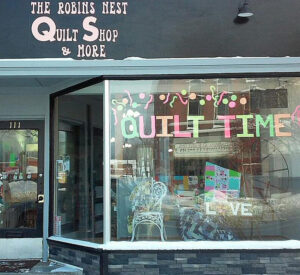 As the girls got older, she started quilting again, mostly self-taught and with the help of a friend.
As the girls got older, she started quilting again, mostly self-taught and with the help of a friend.
“Ten years ago, I decided to leave Oswego Industries — not having a clue to what I was going to do. I decided to open a quilt shop. Always wanting to do something in retail, loving fabrics and colors and a skill for teaching, what better than a quilt shop?!” she said.
“So it began. Ten years ago I rented a spot and opened the doors [of The Robin’s Nest Quilt Shop & More]. Selling fabrics and teaching classes,” she continued. “Two years later, I purchased [this] building and continued on. I bought this building; I own the three floors. I have a rental up on the second floor. I had tenants for seven years and they just left. The third floor is just there; we’re not really doing anything with it.”
She teaches classes to disabled adults and individuals on a regular basis. She does classes; four or five people at the most — “run them just about daily, every day, all day long.”
With the disabled adults, they do quilt projects where they keep some and donate a lot to the community. They have donated dog beds to the Humane Society of Oswego County, and quilts to The Vera House, the pregnancy center, Soldier On and many more.
“I worked with the disabled for many years. We did quilting — now they come here for classes. Thursdays is LIFE (Lasting Integration For Everyone). The whole concept is to integrate them with society. So one of the things they do is they come here on Thursday and they sew and then we either donate projects some place, that’s their community function in the whole program, or they get to keep it. So usually we do one that they get to keep and then the next one we find some place that we want to donate to.”
Her students range from 7-87 years old.
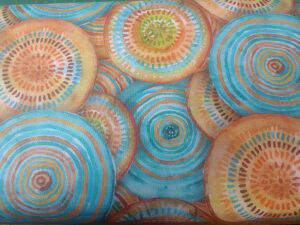 Besides teaching, she offers long arm service, which is putting the three layers of the quilt together.
Besides teaching, she offers long arm service, which is putting the three layers of the quilt together.
“I also do special order quilts, many of which are T-shirt quilts. These are usually for graduation, using their clothing from sports throughout school years,” she said. “Also a lot of them are quilts from [clothing of] a loved one who has passed, called memory quilts. They have reported to me how much comfort they find in wrapping up in these quilts. They wrap themselves in the quilt and it’s comforting.”
Back in the day, they filled quilts with a lot of things.
“Some times, they had old wool blankets laying around and they’d use them to fill in the middle of the quilt,” she said, adding, “But even today’s quilts can get pretty heavy. We go to make our bed [with a quilt] and my husband goes ‘that’s a lot of weight.’ But a lot of people like it. They are even buying weighted blanket because they like the pressure of it.”
She uses modern sewing machines in her classes.
“Up in my front window, I had the old treadle machine. I used to have it set up on the floor so people could check it out and try it. I didn’t want it to get broken so I put it back up,” she said. “Some of the old machines — some of the ladies are going back to it because they just love the stitch that it does. They’re still good — it’s not easy to kill a sewing machine.”
She also had a large quilt, depicting several cute puppies, in her front window. “I had people come in asking if I sold dogs,” she laughed.
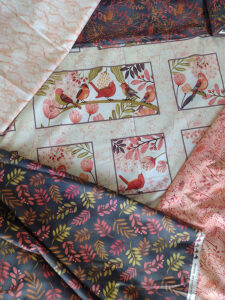 “I’ve got everything from the old machines to the newer machines, fabrics and everything else you might need to make your quilt. When it comes to fabric, I might not carry it. I am a very small quilt shop compared to a lot of them, and there are some of them that are smaller than me. Some people come in and they are just buying fabric to go home and make their quilt,” she said. “Some people come in and they want a quilt, but they don’t know what they want — I’ve had people come in ‘just make me a quilt, I don’t care.’ But I’m not playing that game, let’s go through the fabrics and you at least pull me some fabrics and we will talk about design and stuff.”
“I’ve got everything from the old machines to the newer machines, fabrics and everything else you might need to make your quilt. When it comes to fabric, I might not carry it. I am a very small quilt shop compared to a lot of them, and there are some of them that are smaller than me. Some people come in and they are just buying fabric to go home and make their quilt,” she said. “Some people come in and they want a quilt, but they don’t know what they want — I’ve had people come in ‘just make me a quilt, I don’t care.’ But I’m not playing that game, let’s go through the fabrics and you at least pull me some fabrics and we will talk about design and stuff.”
Making a quilt is like putting together a puzzle, she said. “If you’re not a puzzle builder, you probably wouldn’t enjoy quilt making. There is a lot of math involved, too. But it’s fun!”
She gets quite a few repeat customers, “I get them from Oswego and Phoenix, Hannibal and Central Square. They come as far as Syracuse and more.”
Throughout the shop you will see some nests with four eggs in them and also on her logo. These represent her girls, she explained.
She gives special thanks to her husband, “who has had my back throughout this journey. He has listened to my worries, been my handyman, my cleaning staff and so much more,” she said.
She also acknowledged her girls “who have given me a helping hand whenever I’ve needed. To some close friends whom have volunteered their time and efforts to help me. And, certainly to my students and patrons — because without them there would be no Robins Nest.”

